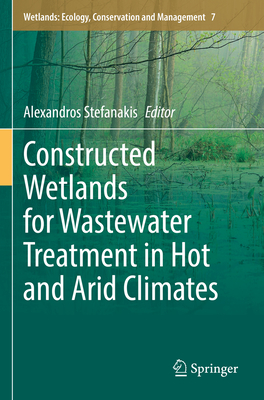图书简介
This edited book presents the first collection of case studies and research projects on the sustainable technology of constructed wetlands for wastewater management under hot and arid climates. It is the first such work that summarizes in a single reference the current international experiences and knowledge on the implementation of this nature-based solution under these diverse and often harsh climatic conditions. It covers the relevant gap in the fragmented and limited literature by providing integrated information and documentation on the feasibility of this green technology.The book presents the treatment efficiency of constructed wetland facilities and the research output from 29 different countries across South America, Africa, Asia and Oceania, while it covers various applications such as domestic and municipal wastewater, various industrial effluents and municipal sludge. Many examples and case studies further demonstrate the potential of this technology to contribute to better address the issues of water scarcity and limited fresh water resources through circular management of treated effluents e.g. reuse in irrigation. It also discusses the various challenges and technical aspects that should be considered in such climates, along with the environmental, financial and social benefits of this technology.This work is a useful handbook and guide for professional engineers, practitioners, academics, researchers, students, and water authorities who wish to get a better understanding and first-hand information on the potential of constructed wetlands for cost-effective and sustainable wastewater management in countries with hot and arid climates.
Chapter 1. Constructed wetlands as a green and sustainable technology for domestic wastewater treatment under the arid climate of rural areas in Morocco (Laila Mandi).- Chapter 2. Efficiency of constructed wetlands and wastewater stabilization ponds for wastewater treatment in northern Algerian Sahara (Khaled Bouchama) .- Chapter 3. A review of constructed wetlands types and plants used for wastewater treatment in Egypt (Mohamed S. Gaballah).- Chapter 4. Two decades of experience on Nature-Based Solutions for wastewater treatment in Egypt, Palestine and Tunisia (F. Masi).- Chapter 5. Constructed Wetlands for wastewater management in Egypt: an overview of 30-years experiences in small / medium-size treatment plants (Hussein I. Abdel-Shafy).- Chapter 6. Constructed wetland as an efficient technology for the treatment of urban/industrial wastewater in the arid regions: Morocco as a model (Ayoub El Ghadraoui).- Chapter 7. Vertical Flow Constructed Wetlands for horticulture wastewater treatment under a hot climate in Ethiopia (Frank van DIEN).- Chapter 8. Constructed Wetlands in a community setting in Mombasa, Kenya (Sarah den Haring).- Chapter 9. Performance of Constructed Wetlands in a hot tropical climate: the case of Tanzania (Jamidu H.Y. Katima).- Chapter 10. Constructed wetlands lessons from Israel, Jordan and Palestine: the effect of plants and filter media on CW performance (Hassan Azaizeh).- Chapter 11. Performance of decentralized Vertical Flow Constructed Wetlands for reuse in agricultural irrigation in Jordan: enhancing nitrogen removal (Ghaida Abdallat).- Chapter 12. Constructed wetlands for sustainable wastewater treatment in Oman: experiences from research and case studies (Alexandros I. Stefanakis).- Chapter 13. Constructed Wetlands for Sustainable Wastewater Treatment – Case Studies from Pakistan (Atif Mustafa).- Chapter 14. Constructed wetland case studies for municipal and glass industry wastewater treatment in Iran (Amir Gholipour).- Chapter 15. Research and case studies of Sludge Treatment Wetlands in hot and arid climates: experiences and opportunities for sustainable sludge management (Alexandros I. Stefanakis).- Chapter 16. Full-scale experiences of arid and semi-1 arid land-based decentralized constructed wetlands in India and China (Meera Keraliya).- Chapter 17. Performance assessment of Constructed Wetland in a semi-arid region in India employing SWOT analysis (Kirti Avishek).- Chapter 18. Novel media and unit configurations in advanced Constructed Wetlands: case studies under hot climate in Thailand (Thammarat Koottatep).- Chapter 19. Treatment Wetlands in Atacama 1 Desert, Chile: experiences and lesson learnt from wastewater treatment and reuse (Ismael Vera-Puerto).- Chapter 20. Wastewater Gardens systems in Yucatan, Mexico; northwest Australia; northern Algeria and southern Iraq (Mark Nelson).- Chapter 21. Selected Constructed Wetlands case studies in Africa, Asian and Latin American countries (M.A. El-Khateeb).
Trade Policy 买家须知
- 关于产品:
- ● 正版保障:本网站隶属于中国国际图书贸易集团公司,确保所有图书都是100%正版。
- ● 环保纸张:进口图书大多使用的都是环保轻型张,颜色偏黄,重量比较轻。
- ● 毛边版:即书翻页的地方,故意做成了参差不齐的样子,一般为精装版,更具收藏价值。
关于退换货:- 由于预订产品的特殊性,采购订单正式发订后,买方不得无故取消全部或部分产品的订购。
- 由于进口图书的特殊性,发生以下情况的,请直接拒收货物,由快递返回:
- ● 外包装破损/发错货/少发货/图书外观破损/图书配件不全(例如:光盘等)
并请在工作日通过电话400-008-1110联系我们。
- 签收后,如发生以下情况,请在签收后的5个工作日内联系客服办理退换货:
- ● 缺页/错页/错印/脱线
关于发货时间:- 一般情况下:
- ●【现货】 下单后48小时内由北京(库房)发出快递。
- ●【预订】【预售】下单后国外发货,到货时间预计5-8周左右,店铺默认中通快递,如需顺丰快递邮费到付。
- ● 需要开具发票的客户,发货时间可能在上述基础上再延后1-2个工作日(紧急发票需求,请联系010-68433105/3213);
- ● 如遇其他特殊原因,对发货时间有影响的,我们会第一时间在网站公告,敬请留意。
关于到货时间:- 由于进口图书入境入库后,都是委托第三方快递发货,所以我们只能保证在规定时间内发出,但无法为您保证确切的到货时间。
- ● 主要城市一般2-4天
- ● 偏远地区一般4-7天
关于接听咨询电话的时间:- 010-68433105/3213正常接听咨询电话的时间为:周一至周五上午8:30~下午5:00,周六、日及法定节假日休息,将无法接听来电,敬请谅解。
- 其它时间您也可以通过邮件联系我们:customer@readgo.cn,工作日会优先处理。
关于快递:- ● 已付款订单:主要由中通、宅急送负责派送,订单进度查询请拨打010-68433105/3213。
本书暂无推荐
本书暂无推荐















